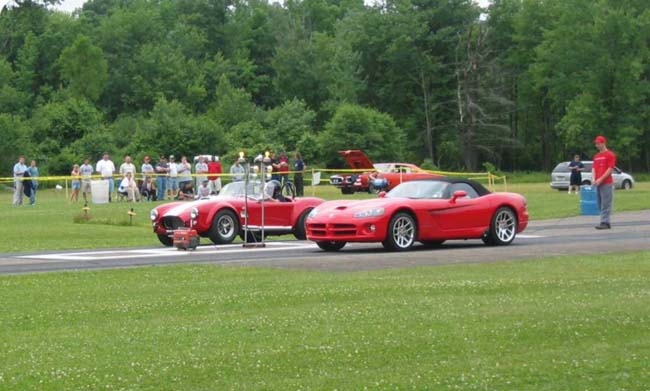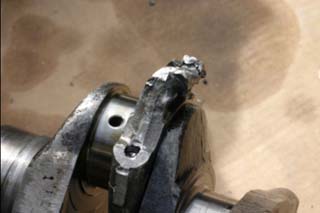
SP 512
The UED (Unintended Engine Disassembly)

I was drag racing my Superformance SP 512 when the 392 engine
unexpectedly failed. Fortunately for me, the only damage was to the
engine. I was going through the traps at about 120 mph when “Bam” the
number one rod and piston self- destructed, locking up the engine. The
back wheels screeched for a fraction of a second before I threw it into
neutral. I noticed that the tach and oil pressure gauges immediately
dropped to zero. It was a bad experience for anyone. It is an experience
that gives you that sinking feeling in the pit of your stomach, knowing
fully well what you have done. I “lunched the block”, or had a “UED”
(unscheduled engine disassembly). The car was flat-bedded home on a
trailer, and I followed with my tail between my legs. |
The Carnage
What caused the failure? Initial investigations showed that “detonation” was the cause of the piston /rod problem, as suggested by Ford. Visual inspection of the motor after disassembly revealed that “fairy dust and marbles” were in the replacement Canton eight quart oil pan, and a gaping hole resided where the number one piston and rod once was. The bottom end of the number one rod was wrapped around the crank and the number 1 cylinder wall was badly gouged. The lower skirt on piston number 5 was broken off, as was the lower part of the cylinder wall. The distributor shaft jammed in the block and was impossible to pull out.. The cylinder head for the number one piston also took a beating, as shattered piston parts beat against the valves and combustion chamber of the # 1 chamber. I bent some push rods as flying junk caused the valves to hang open allowing the returning piston to do it’s damage. This all happened in the blink of an eye. There is no real way for me to determine what caused the problem, but a hint from the racing world points out that Ford presently installs forged pistons (in place of the original Speed-Pro hypereutectic cast slugs) in the latest 392’s. That would be a tip off that the original cast pistons were not up to the task. I was using Sunoco 94 octane gasoline with the 9.7 compression ratio pistons, so there shouldn’t have been a detonation problem. Although telephone conversations initially seemed promising about “fixing” my engine, they were eventually unproductive. After removing the engine, I took the opportunity to examine some rod and main caps, thinking that the engine failure was the result of an oiling problem. Other 392 engines have had a bad reputation for failing due to low oil pressure. Interestingly, the rod bearings looked good, as did most of the mains, but the # 4 main bearing was worn through to the copper on the main bearing cap side (according to Ford this was an indication of detonation). Right after I purchased this Ford 392 crate motor I heard some bad things about it’s 40 lbs operating oil pressure as being too low. I immediately attempted to rectify this problem by replacing the oil pan with a Canton large capacity baffled oil pan and also installing a higher, adjustable pressure Melling oil pump. This retrofit resulted in only 5 more lbs (to 45-50 lbs) of oil pressure over the original system. Eventually I bypassed the Superformance oil cooler entirely and my cold start up oil pressure jumped to 60 lbs, dropping to 50-55 lbs under normal hot operating temperatures. It is interesting to note that the Ford spec sheet, as supplied with the engine, highly recommends the use of an oil cooler even although verbal communication with Ford’s Tech Line suggests that I NOT use one. This contradiction of facts is further compounded by the fact that Ford does not give minimum specs for oil cooling line inside diameters or flow capacity requirements that they require for their oil cooling recommendations. It becomes easy for them to infer that an engine failure was not their problem, if their oil flow requirements were never followed, even if they never give you their oil flow requirements to begin with. Ford informed me that if the bottom main bearing cap has copper showing through it is an indication of “detonation”. If the top half in the block shows copper, it is a result of engine imbalance. In my situation, both halves, top and bottom, showed copper suggesting that both a detonation AND an imbalance situation occurred. |
 The number one connecting rod snapped either as a result of the piston causing the rod to break, or the rod causing the piston to break. Either way, the broken rod end wrapped itself around the crank.
The broken rod thrashed around inside bore number one, making deep gouges in the wall. The piston wall skirt on the bottom of number five bore was also broken off. Basically the block is unusable as the cost of inserting sleeves in two bores is probably more than a new block.
Flying piston and rod fragments did serious damage to the head and valves of the number one cylinder. But being aluminum, I was told it can probably be repaired.
When the engine blew, piston parts went everywhere. A piece of piston made it’s way up into the intake manifold and down another intake runner!!! The piece was big enough to lodge the intake valve in the open position.
The main bearing in the cap of number four was worn through to the copper backing. Inadequate oiling issues of the crankshaft and rod bearings affecting reliability of the 392 stroker crate motor have been around for a long time. This problem, apparently, is not an isolated incident.
The thrust bearing, too, has the copper showing. Crankshaft endplay may have been excessive, although Ford claims that this bearing is supplied with copper showing on the thrust surfaces. |